“Don’t readers ever get tired of being told that the world is coming to a nasty, ugly end and only a very few people will survive, by luck and by violence?” That’s the question asked by legendary science fiction author Ursula K. Le Guin during her 2016 interview published by The Nation. It was a poignant question when it was asked. Five years later, the answer is echoing throughout the halls of the literary world, and it’s a clear and resounding yes!
Solarpunk is an artistic and cultural movement that encompasses, but isn’t limited to, areas such as art, technology, architecture, fashion, film, cuisine, and of course literature. From a literary perspective, it’s a subgenre of science fiction that was born out of, and perhaps is the next logical step after, cyberpunk. Solarpunk stories take place in futures where humanity, technology, and nature live in harmony rather than in conflict. Often, solarpunk stories deal with hypothetical technological innovations that help humanity avert or creatively adapt to climate change. And while solarpunk tales don’t necessarily take place in utopias, they are definitely not dystopias. Rather, they are overflowing with hopeful characters and communities optimistically striving to create a new and better world.
Two new literary magazines focusing on solarpunk have come into existence over the past year. Solarpunk Society, which is part of the Civilization Explorer online mobile app and gaming project, just released its fourth issue and is a short magazine that interviews and highlights architects, artists, and writers working in the solarpunk genre. The other is Solarpunk Magazine. Launching its first issue in January 2022, it aims to publish solarpunk short stories, poetry, and nonfiction articles about optimistic solarpunk communities, climate change solutions, and other related topics. Of course those two zines build on the work done by others such as Reckoning and Optopia, which have both been around for a number of years now.
It’s a perfect time to take stock of some of the seminal works of solarpunk fiction that have helped build the foundation for the subgenre’s grand coming out party. Below, listed in no particular order, are five essential works of solarpunk fiction that should be on the bookshelf of not just every solarpunk fan, but also of everyone who loves science fiction and fantasy in general.
I make no claim to these being the best or the top works of solarpunk fiction. There are classic novels written in the 1970s—long before the term “solarpunk” ever fell from anyone’s lips—such as Ursula K. Le Guin’s The Dispossessed, Starhawk’s The Fifth Sacred Thing, and Ernest Calenbach’s Ecotopia that aren’t on this list. And there are plenty of other books written since the advent of the term that are worthy of a list of essential solarpunk titles. But these are five I particularly enjoyed reading, and which have stuck with me ever since.
The Summer Prince by Alaya Dawn Johnson
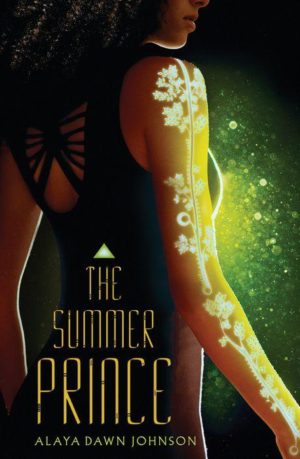
An early example of the budding Afro and Amazofuturism movements, The Summer Prince by Alaya Dawn Johnson takes place in a future Brazilian city that strikes a wonderful balance between technological progress and Brazil’s Indigenous, Latinx, and African ancestral cultures. At its heart, The Summer Prince is an endearing love story about two artists named June and Enki. Together, they use powerful art exhibitions to challenge social norms and foment rebellion against a government that has decided to restrict new technology.
Johnson’s novel has excellent character development, an exciting plot, and is a fantastic example of the internationalist tendency in solarpunk futures. In fact, in 2019 The Best Sci Fi Books listed The Summer Prince second on its list of the sixteen best solarpunk books, right between the classics The Dispossessed and Ecotopia. It’s safe to say this book should be on any list of key solarpunk works.
The Glass and Gardens Series edited by Sarena Ulibarri
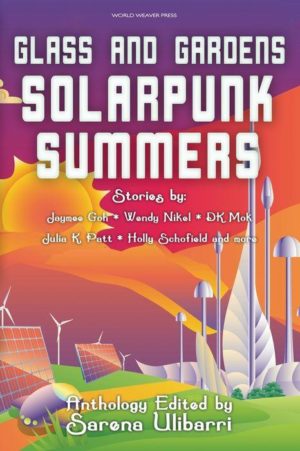
The Glass and Gardens series is made up of two short story anthologies. Solarpunk Summers and Solarpunk Winters were edited by Sarena Ulibarri and published by World Weaver Press. Summers was the first book of solarpunk fiction I ever read, and I firmly believe both books are classics of solarpunk literature.
Solarpunk Summers contains stories with themes ranging from the relationship between technology and nature, to creativity and adaptation, food ethics, and more. The follow up anthology, Solarpunk Winters, is thematically more focused. It specifically explores what future solarpunk societies might be like during the winter season. Taking that central concept, Ulibarri curates a book of exceptional and diverse stories. They’re stories of survival and of normal people who rise above extreme and extraordinary situations. They’re stories about communities tackling challenges, rethinking the way cities function and are organized, and creating small utopias within the ashes of destruction.
In addition to these two, Sarena Ulibarri and World Weaver Press have published a number of solarpunk books. They are an author, editor, and publishing company that should be on every solarpunk’s radar.
Foxhunt by Rem Wigmore
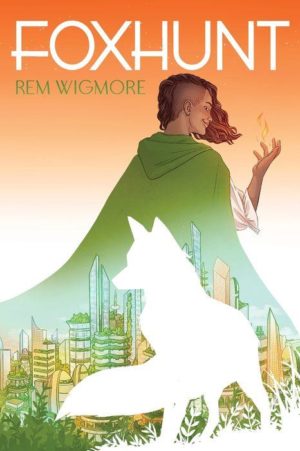
Until Foxhunt, the new novel by Rem Wigmore, it had been years since I read a book cover to cover in one sitting. Just released in August 2021 by Queen of Swords Press, Foxhunt takes place in a deliciously verdant solarpunk future where plants have cleaned the poisonous air, people generally live in harmony, and new customs and regulations protect the planet and its natural resources. When needed, greedy hoarders are dealt with by an organization of bounty hunters called the Order of the Vengeful Wild.
Orfeus, the story’s protagonist, has her life thrown into chaos when the most notorious of the bounty hunters mistakenly thinks she’s an energy criminal and begins to hunt her. The story is full of missteps, twists, and enemies turned allies. It’s an adventure that keeps you reading page after page, and has moments that reflect both the harsh realities of life and the unique tenderness and compassion of which people are capable.
The book’s central focus on LGBtQIA+ characters and storylines is significant. It’s indicative of one of solarpunk’s defining features: characters from communities that are marginalized and historically oppressed, and future worlds that reflect the real, genuine diversity and equality that must exist for any story or society to be appropriately deemed a utopia.
New York 2140 by Kim Stanley Robinson
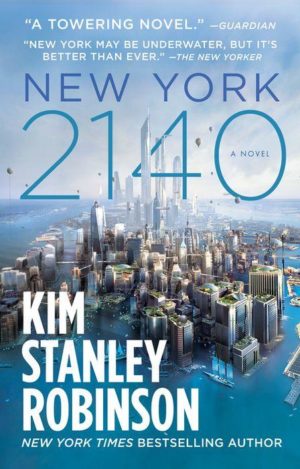
Kim Stanley Robinson’s 2017 climate fiction novel, New York 2140, is a hefty six hundred plus page tome set in a futuristic New York City. Fifty feet of climate change induced sea level rise has left the vast majority of the metropolis under water. Social stratification still exists in Robinson’s solarpunk future, with the upper class living in brand new skyscrapers uptown where the city hasn’t been flooded. Everyone else lives below 46th St. where the city resembles a new Venice.
While most of the U.S. has been purposefully abandoned to wildlife, the people of lower Manhattan work together to come up with creative solutions that enable them to adapt to their predicament. Most of the city’s inhabitants live on the upper stories of buildings, for example. Flood prevention technologies and boat storage allow New York City residents to adapt and make the best out of what otherwise might seem like a bleak future.
New York 2140 is about communities working together, cooperating, and pooling resources to adapt to climate change and overcome adversity. In that sense, it’s a perfect example of what solarpunk is all about, futures in which people are optimistically striving for a better world and the utopian ideal. Its criticisms of capitalism and market economics also make it a prime example of the political ideals and trends within the wider solarpunk movement. Kim Stanley Robinson, a giant in the world of climate fiction and solarpunk, is a must read author for science fiction fans.
Suncatcher: Seven Days in the Sky by Alia Gee

Suncatcher is by far one of the most fun books I’ve read. Alia Gee’s 2014 novel takes place in a near-future that has survived pandemics, climate change, and peak oil. Like all good solarpunk, however, the story is not without compelling conflict and tension.
That tension begins ratcheting up after professor Radicand Jones decides to visit her sister’s solar-powered airship. The professor is on sabbatical, but her relaxing vacation turns into a swashbuckling adventure in which the professor finds herself defending the airship, its pack, and those she cares about against marauding pirates, bounty hunters, and more.
Gee’s book has characters with depth, an engaging plot, evil corporations, love, virtual reality and more. It’s a story grounded in solarpunk’s innately hopeful and optimistic perspective, and that aptly demonstrates the sibling rivalry between cyberpunk and solarpunk as literary subgenres. As an early and important example of solarpunk storytelling, Suncatcher is a must read.
Justine Norton-Kertson (they/he/she) is a writer, publisher, musician, photographer, and community organizer. They are the founding editor of Solarpunk Magazine and Black Cat Magazine. He lives in rural Oregon with her partner, puppy, cats, goats, and beehives. They can be found on Twitter and Instagram @jankwrites.










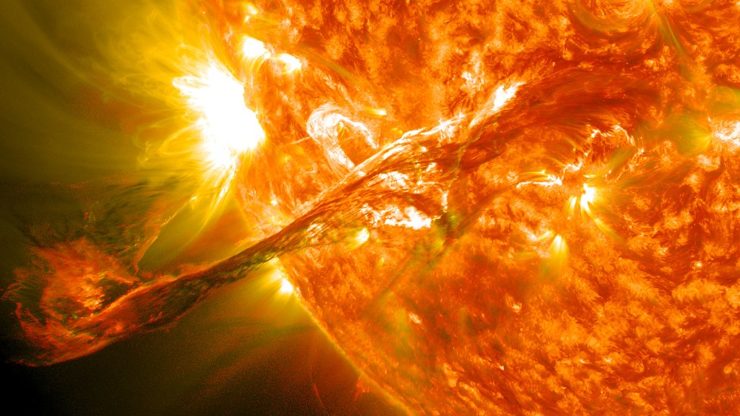

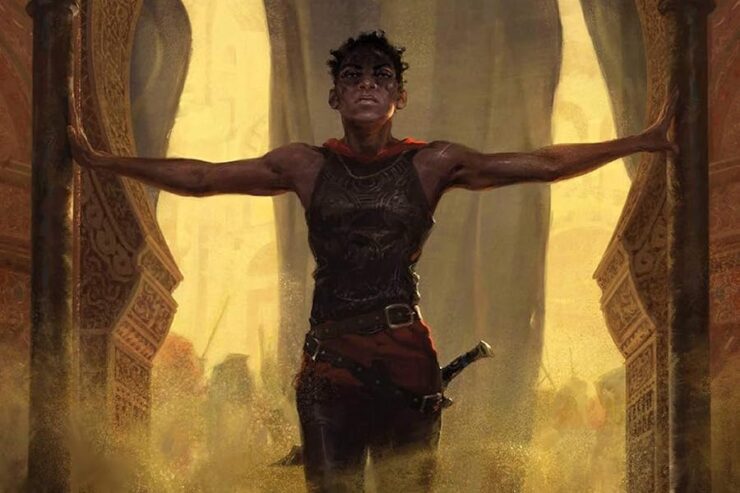
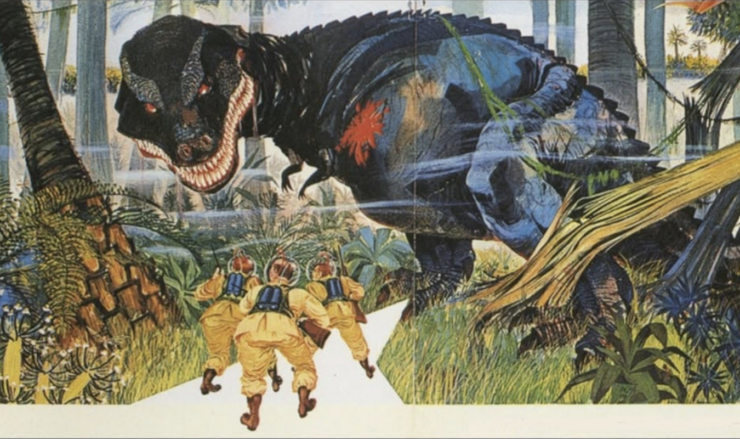

A heads up to any scuba people past and present: 2140 will make you twitch, and not in a good way. It’s all the Emperor’s New Wetsuit. Robinson has children hookah diving in the East River on a jury rig set up of their own contrivance. Yeah. Sudden and horrible death for any of a dozen reasons. I kept trying and trying, but the stupidities kept piling up and up. I could not finish the book. The author is supposed to be all hard science and tech savvy, but clearly hasn’t so much as audited an intro scuba lecture at the local Y.
Space may be dangerous, but nowhere near so much as the bottom of the East River.
Just in general, it’s difficult to enjoy a story while you are repeatedly asked to ignore inconsistencies, impossibilities and just sloppy research. But the fails here are so many and so blatant that you have to ask yourself, how much of Robinson’s space stuff is BS as well?
I remember watching a panel on YouTube that included Robinson, and one of his fans got up and took a potshot at Paulo Bacigalupi because in The Windup Girl there was a mention of genetically-engineered cats that had replaced all the other cats. The comment was THAT’S NOT HOW EVOLUTION WORKS. True enough, but it was a paragraph, if that, a throwaway and not central to the plot. To snipe at Bacigalupi for it while holding up Kim Stanley Robinson for scientific accuracy?
I
just
can’t…
As a 10 yr old in Brazil, my brothers and I came up with an awesome plan to explore the local lagoon by breathing through a handy garden hose while metres down at the bottom. The reason I am alive to type this is because we very uncharacteristically tested it at a very shallow depth to discover breathing does not work under such conditions.
Personally, I am a moderate who believes there’s room to critique all the stupid bits in Robinson’s fiction while mocking the different but equally stupid bits in Bacigalupi’s. On the one hand, orbital dynamics worthy of AE Van Vogt. On the other, springs whose power density even Edmund Hamilton would wonder about.
Thanks for a great article, Justine! I look forward to reading more of these stories.
@1. gingerbug
I love you! That drove me crazy too!
I’m fine hand waving “future tech”, but things we use NOW, when that gets screwed up….grrrrrrrrrrr .
.
There’s an interesting sort of pre-solar punk novel by Norman Spinrad: Songs from the Stars, which Foxhunt reminded me a little of (although Foxhunt for the most part has sympathetic characters whereas Songs for some explicable reason has characters who sound like they were all written by Norman Spinrad). One of the questions the characters in Songs try very hard not to ask was “if we’re limiting ourselves to ecologically clean tech, where do our computer chips and solar panels come from?” The protagonists very reluctantly are forced to deal with the answer.
Anyone read Sun of Suns by Karl Schroeder? It feels very Solarpunk, in that there are artificial stars and a fair amount of “punks” running / flying around. However it doesn’t have much to do with the more recent Solarpunk genre forms.
I’d rec Becky Chambers’ A Psalm for the Wild-Built for its post-adaptation society in which a massive tract of land is essentially off-limits to humans so it can return fully to nature. And robots. People reclaim their grey water, use solar power, and generally strive to be aware of how their actions ripple out to affect everyone and everything around them. The protagonist is a tea monk in a period of personal growth. Slice-of-life-ish, full of kindness and self-reflection. This one has really stuck with me.
2140 has the usual Robinson problems with economic difficulties resolved by And Then A Miracle Occurs. Sure, Tony Robbins was right when he said, ‘if you have a problem that can be resolved with money and you have the money, you should no longer have a problem’. Robinson pulls that rabbit out of a hat in more than one of his works, and does it fairly obviously here.
@7.teg yes! I just read A Psalm for the Wild-Built after this was published. If I had read it before, then it absolutely would have made this list.